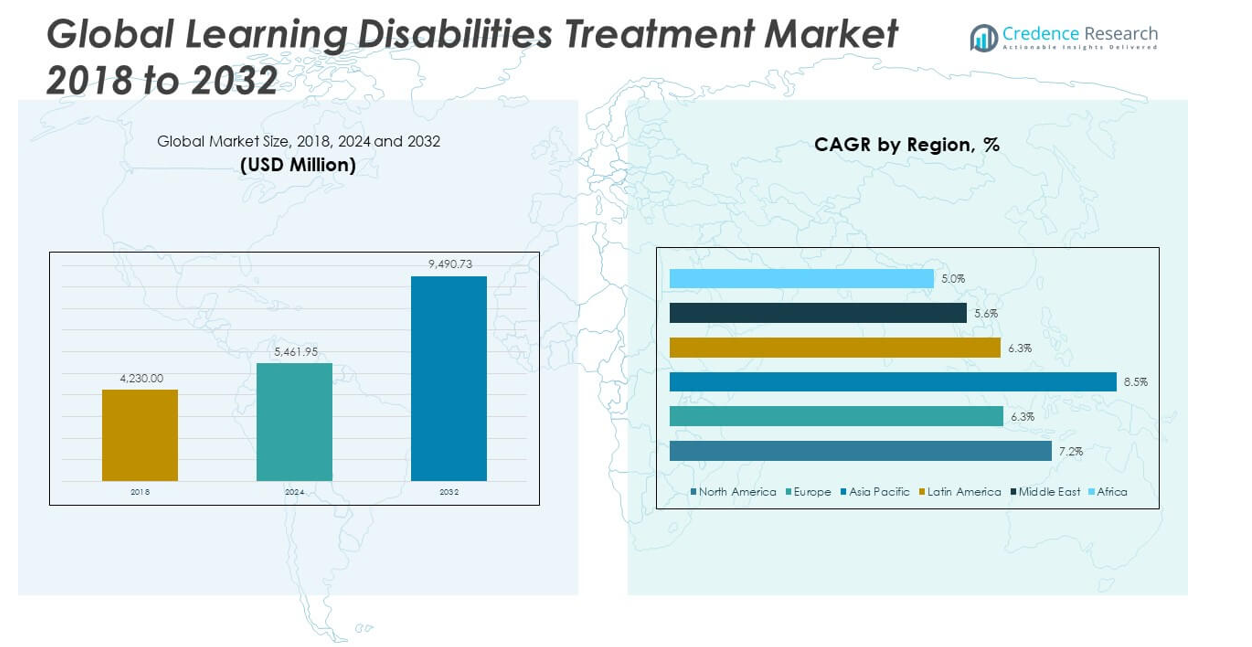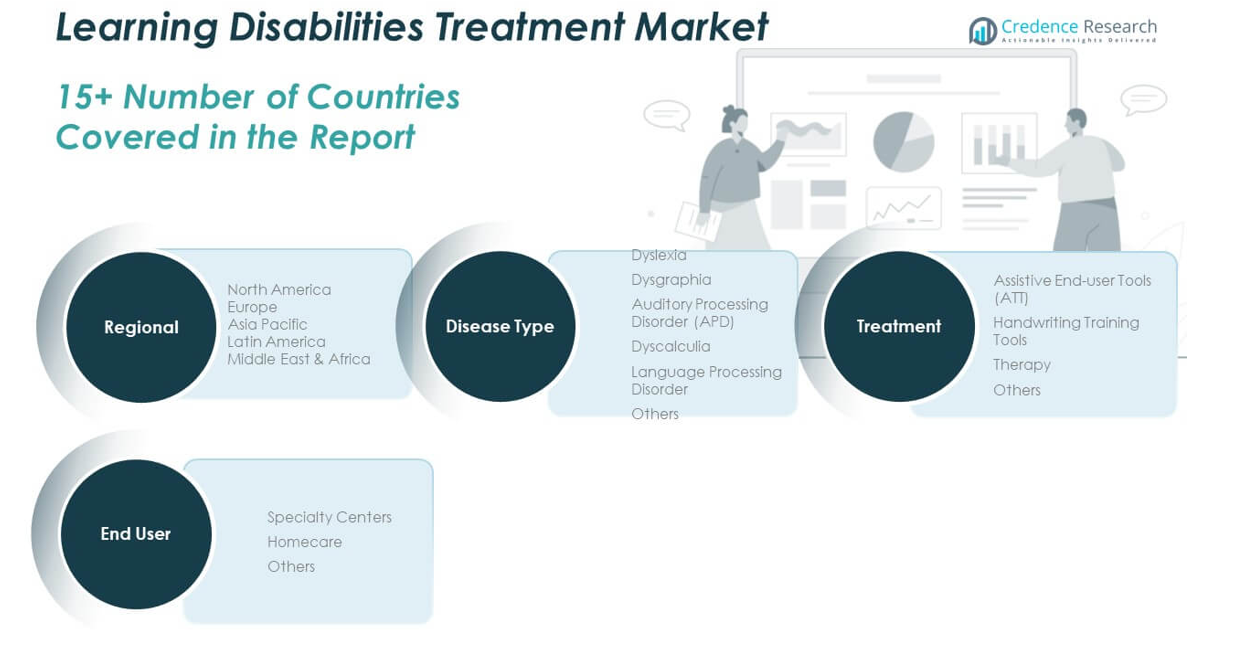CHAPTER NO. 1 : GENESIS OF THE MARKET
1.1 Market Prelude – Introduction & Scope
1.2 The Big Picture – Objectives & Vision
1.3 Strategic Edge – Unique Value Proposition
1.4 Stakeholder Compass – Key Beneficiaries
CHAPTER NO. 2 : EXECUTIVE LENS
2.1 Pulse of the Industry – Market Snapshot
2.2 Growth Arc – Revenue Projections (USD Million)
2.3. Premium Insights – Based on Primary Interviews
CHAPTER NO. 3 : LEARNING DISABILITIES TREATMENT MARKET FORCES & INDUSTRY PULSE
3.1 Foundations of Change – Market Overview
3.2 Catalysts of Expansion – Key Market Drivers
3.2.1 Momentum Boosters – Growth Triggers
3.2.2 Innovation Fuel – Disruptive Technologies
3.3 Headwinds & Crosswinds – Market Restraints
3.3.1 Regulatory Tides – Compliance Challenges
3.3.2 Economic Frictions – Inflationary Pressures
3.4 Untapped Horizons – Growth Potential & Opportunities
3.5 Strategic Navigation – Industry Frameworks
3.5.1 Market Equilibrium – Porter’s Five Forces
3.5.2 Ecosystem Dynamics – Value Chain Analysis
3.5.3 Macro Forces – PESTEL Breakdown
3.6 Price Trend Analysis
3.6.1 Regional Price Trend
3.6.2 Price Trend by product
CHAPTER NO. 4 : KEY INVESTMENT EPICENTER
4.1 Regional Goldmines – High-Growth Geographies
4.2 Product Frontiers – Lucrative Product Categories
4.3 Treatment Sweet Spots – Emerging Demand Segments
CHAPTER NO. 5: REVENUE TRAJECTORY & WEALTH MAPPING
5.1 Momentum Metrics – Forecast & Growth Curves
5.2 Regional Revenue Footprint – Market Share Insights
5.3 Segmental Wealth Flow – Disease Type & Treatment Revenue
CHAPTER NO. 6 : TRADE & COMMERCE ANALYSIS
6.1.Import Analysis by Region
6.1.1. Global Learning Disabilities Treatment Market Import Revenue By Region
6.2.Export Analysis by Region
6.2.1. Global Learning Disabilities Treatment Market Export Revenue By Region
CHAPTER NO. 7 : COMPETITION ANALYSIS
7.1.Company Market Share Analysis
7.1.1. Global Learning Disabilities Treatment Market: Company Market Share
7.2. Global Learning Disabilities Treatment Market Company Revenue Market Share
7.3.Strategic Developments
7.3.1.Acquisitions & Mergers
7.3.2. New Product Launch
7.3.3. Regional Expansion
7.4. Competitive Dashboard
7.5. Company Assessment Metrics, 2024
CHAPTER NO. 8 : LEARNING DISABILITIES TREATMENT MARKET – BY DISEASE TYPE SEGMENT ANALYSIS
8.1.Learning Disabilities Treatment Market Overview by Disease Type Segment
8.1.1. Learning Disabilities Treatment Market Revenue Share By Disease Type
8.2. Dyslexia
8.3. Dysgraphia
8.4. Auditory Processing Disorder (APD)
8.5. Dyscalculia
8.6. Language Processing Disorder
8.7. Others
CHAPTER NO. 9 : LEARNING DISABILITIES TREATMENT MARKET – BY TREATMENT SEGMENT ANALYSIS
9.1.Learning Disabilities Treatment Market Overview by Treatment Segment
9.1.1. Learning Disabilities Treatment Market Revenue Share By Treatment
9.2. Assistive End-user Tools (ATT)
9.2.1 Personal Listening Devices
9.2.2 Sound Field Systems
9.2.3 Others
9.3. Handwriting Training Tools
9.3.1 Portable Word Processors
9.3.2 Proofreading Software
9.3.3 Others
9.4. Therapy
9.4.1 Occupational Therapy
9.4.2 Speech Therapy
9.4.3 Others
9.5. Others
CHAPTER NO. 10 : LEARNING DISABILITIES TREATMENT MARKET – BY END-USER SEGMENT ANALYSIS
10.1.Learning Disabilities Treatment Market Overview by End-user Segment
10.1.1. Learning Disabilities Treatment Market Revenue Share By End-user
10.2. Specialty Centers
10.3. Homecare
10.4. Others
CHAPTER NO. 11 : LEARNING DISABILITIES TREATMENT MARKET – REGIONAL ANALYSIS
11.1.Learning Disabilities Treatment Market Overview by Region Segment
11.1.1. Global Learning Disabilities Treatment Market Revenue Share By Region
11.1.3.Regions
11.1.4.Global Learning Disabilities Treatment Market Revenue By Region
.1.6.Disease Type
11.1.7.Global Learning Disabilities Treatment Market Revenue By Disease Type
11.1.9.Treatment
11.1.10. Global Learning Disabilities Treatment Market Revenue By Treatment
11.1.12.End-user
11.1.13. Global Learning Disabilities Treatment Market Revenue By End-user
CHAPTER NO. 12 : NORTH AMERICA LEARNING DISABILITIES TREATMENT MARKET – COUNTRY ANALYSIS
12.1. North America Learning Disabilities Treatment Market Overview by Country Segment
12.1.1.North America Learning Disabilities Treatment Market Revenue Share By Region
12.2.North America
12.2.1.North America Learning Disabilities Treatment Market Revenue By Country
12.2.2.Disease Type
12.2.3.North America Learning Disabilities Treatment Market Revenue By Disease Type
12.2.4.Treatment
12.2.5.North America Learning Disabilities Treatment Market Revenue By Treatment
2.2.6.End-user
12.2.7.North America Learning Disabilities Treatment Market Revenue By End-user
2.3.U.S.
12.4.Canada
12.5.Mexico
CHAPTER NO. 13 : EUROPE LEARNING DISABILITIES TREATMENT MARKET – COUNTRY ANALYSIS
13.1. Europe Learning Disabilities Treatment Market Overview by Country Segment
13.1.1. Europe Learning Disabilities Treatment Market Revenue Share By Region
13.2.Europe
13.2.1.Europe Learning Disabilities Treatment Market Revenue By Country
13.2.2.Disease Type
13.2.3.Europe Learning Disabilities Treatment Market Revenue By Disease Type
13.2.4.Treatment
13.2.5. Europe Learning Disabilities Treatment Market Revenue By Treatment
13.2.6.End-user
13.2.7. Europe Learning Disabilities Treatment Market Revenue By End-user
13.3.UK
13.4.France
13.5.Germany
13.6.Italy
13.7.Spain
13.8.Russia
13.9. Rest of Europe
CHAPTER NO. 14 : ASIA PACIFIC LEARNING DISABILITIES TREATMENT MARKET – COUNTRY ANALYSIS
14.1.Asia Pacific Learning Disabilities Treatment Market Overview by Country Segment
14.1.1.Asia Pacific Learning Disabilities Treatment Market Revenue Share By Region
14.2.Asia Pacific
14.2.1. Asia Pacific Learning Disabilities Treatment Market Revenue By Country
14.2.2.Disease Type
14.2.3.Asia Pacific Learning Disabilities Treatment Market Revenue By Disease Type
14.2.4.Treatment
14.2.5.Asia Pacific Learning Disabilities Treatment Market Revenue By Treatment
14.2.5.End-user
14.2.7.Asia Pacific Learning Disabilities Treatment Market Revenue By End-user
14.3.China
14.4.Japan
14.5.South Korea
14.6.India
14.7.Australia
14.8.Southeast Asia
14.9. Rest of Asia Pacific
CHAPTER NO. 15 : LATIN AMERICA LEARNING DISABILITIES TREATMENT MARKET – COUNTRY ANALYSIS
15.1. Latin America Learning Disabilities Treatment Market Overview by Country Segment
15.1.1.Latin America Learning Disabilities Treatment Market Revenue Share By Region
15.2. Latin America
15.2.1. Latin America Learning Disabilities Treatment Market Revenue By Country
15.2.2.Disease Type
15.2.3. Latin America Learning Disabilities Treatment Market Revenue By Disease Type
15.2.4.Treatment
15.2.5.Latin America Learning Disabilities Treatment Market Revenue By Treatment
15.2.6.End-user
15.2.7.Latin America Learning Disabilities Treatment Market Revenue By End-user
15.3.Brazil
15.4.Argentina
15.5.Rest of Latin America
CHAPTER NO. 16 : MIDDLE EAST LEARNING DISABILITIES TREATMENT MARKET – COUNTRY ANALYSIS
16.1. Middle East Learning Disabilities Treatment Market Overview by Country Segment
16.1.1.Middle East Learning Disabilities Treatment Market Revenue Share By Region
16.2.Middle East
16.2.1. Middle East Learning Disabilities Treatment Market Revenue By Country
16.2.2.Disease Type
16.2.3.Middle East Learning Disabilities Treatment Market Revenue By Disease Type
16.2.4.Treatment
16.2.5.Middle East Learning Disabilities Treatment Market Revenue By Treatment
16.2.6. End-user
16.2.7.Middle East Learning Disabilities Treatment Market Revenue By End-user
16.3.GCC Countries
16.4. Israel
16.5. Turkey
16.6.Rest of Middle East
CHAPTER NO. 17 : AFRICA LEARNING DISABILITIES TREATMENT MARKET – COUNTRY ANALYSIS
17.1. Africa Learning Disabilities Treatment Market Overview by Country Segment
17.1.1.Africa Learning Disabilities Treatment Market Revenue Share By Region
17.2. Africa
17.2.1.Africa Learning Disabilities Treatment Market Revenue By Country
17.2.2.Disease Type
17.2.3.Africa Learning Disabilities Treatment Market Revenue By Disease Type
17.2.4.Treatment
17.2.5. Africa Learning Disabilities Treatment Market Revenue By Treatment
17.2.6.End-user
17.2.7. Africa Learning Disabilities Treatment Market Revenue By End-user
17.3. South Africa
17.4.Egypt
17.5.Rest of Africa
CHAPTER NO. 18 : COMPANY PROFILES
18.1. Sonova Group
18.1.1.Company Overview
18.1.2.Product Portfolio
18.1.3.Financial Overview
18.1.4.Recent Developments
18.1.5.Growth Strategy
18.1.6.SWOT Analysis
18.2. Origin Instruments Corporation
18.3. Kurzweil Education
18.4. Ginger Software, Inc.
18.5. Koninklijke Philips N.V.
18.6. Sight and Sound Technology
18.7. Oticon
18.8. Adaptive Tech Solutions, LLC
18.9. Speech Therapy Works
18.10. Ghotit Ltd.









